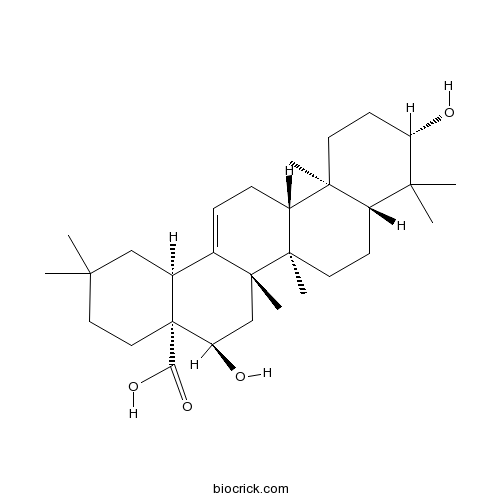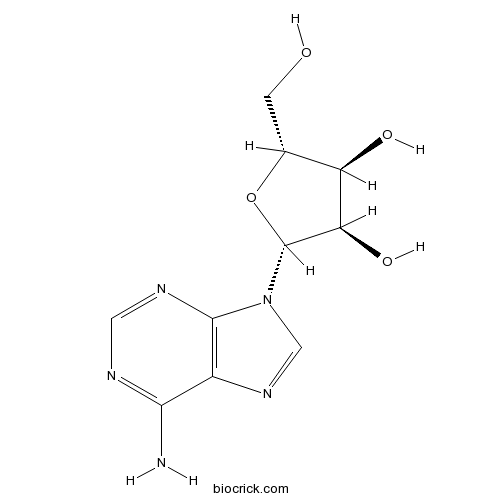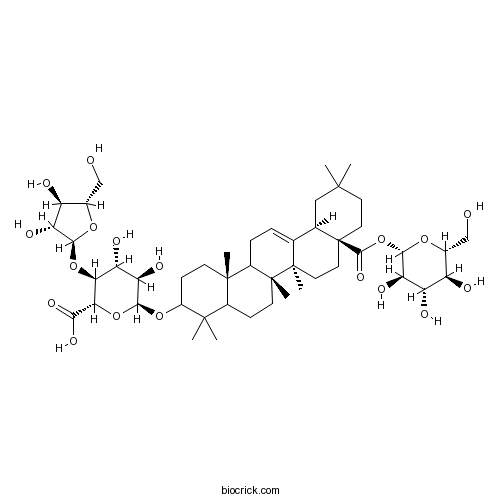Aralia elata
Aralia elata
1. The products in our compound library are selected from thousands of unique natural products; 2. It has the characteristics of diverse structure, diverse sources and wide coverage of activities; 3. Provide information on the activity of products from major journals, patents and research reports around the world, providing theoretical direction and research basis for further research and screening; 4. Free combination according to the type, source, target and disease of natural product; 5. The compound powder is placed in a covered tube and then discharged into a 10 x 10 cryostat; 6. Transport in ice pack or dry ice pack. Please store it at -20 °C as soon as possible after receiving the product, and use it as soon as possible after opening.
Natural products/compounds from Aralia elata
- Cat.No. Product Name CAS Number COA
-
BCN5628
Echinocystic acid510-30-5
Instructions

-
BCN5796
Adenosine58-61-7
Instructions

-
BCN2683
Chikusetsusaponin IV7518-22-1
Instructions

Eclalbasaponin I from Aralia elata (Miq.) Seem. reduces oxidative stress-induced neural cell death by autophagy activation.[Pubmed: 29091860]
None
Aralia elata (Miq) Seem Extract Decreases O-GlcNAc Transferase Expression and Retinal Cell Death in Diabetic Mice.[Pubmed: 29040017]
Aralia elata (Miq) Seem (AES) is a medicinal plant used in traditional Chinese and Korean medicine for the treatment of several diseases, including diabetes. This study aimed to investigate the neuroprotective effect of AES extract against high glucose-induced retinal injury in diabetic mice. AES extract (20 and 100 mg/kg body weight) was orally administered to control mice or mice with streptozotocin-induced diabetes. Protein levels of O-linked β-N-acetylglucosamine (O-GlcNAc) transferase (OGT), carbohydrate-responsive element-binding protein (ChREBP), sterol regulatory element-binding protein (SREBP)-1, thioredoxin-interacting protein (TXNIP), fatty acid synthase (FAS), and acetyl CoA carboxylase (ACC) were analyzed by western blotting. Colocalization of terminal deoxynucleotide transferase-mediated dUTP nicked-end labeling (TUNEL)-positive ganglion cells and OGT, ChREBP, or TXNIP were monitored using double immunofluorescence analysis. Interaction between ChREBP and OGT was assessed using coimmunoprecipitation analysis. AES extract protected the retinas from neuronal injury and decreased levels of OGT, ChREBP, TXNIP, SREBP-1, FAS, and ACC in the diabetic retinas. AES extract reduced colocalization of TUNEL-positive ganglion cells and OGT, ChREBP, or TXNIP in the diabetic retinas. Coimmunoprecipitation analysis indicated that AES extract reduced interaction between ChREBP and OGT and attenuated ganglion cell death in diabetic retinas. Moreover, the ChREBP that colocalized with OGT or the TUNEL signal was significantly decreased in diabetic mice treated with AES extract. These findings show that AES extract can alleviate OGT-, ChREBP-, TXNIP-, or SREBP-1-related retinal injury in diabetic retinopathy.
Rapid amplification of four retrotransposon families promoted speciation and genome size expansion in the genus Panax.[Pubmed: 28831052]
Genome duplication and repeat multiplication contribute to genome evolution in plants. Our previous work identified a recent allotetraploidization event and five high-copy LTR retrotransposon (LTR-RT) families PgDel, PgTat, PgAthila, PgTork, and PgOryco in Panax ginseng. Here, using whole-genome sequences, we quantified major repeats in five Panax species and investigated their role in genome evolution. The diploids P. japonicus, P. vietnamensis, and P. notoginseng and the tetraploids P. ginseng and P. quinquefolius were analyzed alongside their relative Aralia elata. These species possess 0.8-4.9 Gb haploid genomes. The PgDel, PgTat, PgAthila, and PgTork LTR-RT superfamilies accounted for 39-52% of the Panax species genomes and 17% of the A. elata genome. PgDel included six subfamily members, each with a distinct genome distribution. In particular, the PgDel1 subfamily occupied 23-35% of the Panax genomes and accounted for much of their genome size variation. PgDel1 occupied 22.6% (0.8 Gb of 3.6 Gb) and 34.5% (1.7 Gb of 4.9 Gb) of the P. ginseng and P. quinquefolius genomes, respectively. Our findings indicate that the P. quinquefolius genome may have expanded due to rapid PgDel1 amplification over the last million years as a result of environmental adaptation following migration from Asia to North America.
Cholesterol-lowering effect of Aralia elata (Miq.) Seem via the activation of SREBP-2 and the LDL receptor.[Pubmed: 28690119]
Hyperlipidemia causes arteriosclerosis, a risk factor for coronary heart disease. Prevention of hyperlipidemia by improving dietary habits has recently attracted attention. In this regard, we investigated whether Aralia elata (Miq.) Seem (AE) extract inhibits hepatic cholesterol accumulation and modulate the cellular signaling pathway.


